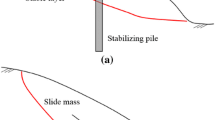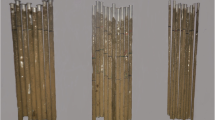Abstract
Stabilizing micropile groups is a light retaining structure constructed quickly and safely for slope reinforcement in practice. To carry out engineering design of any structure, a simplified analytical procedure for a micropile group with consideration of stability of the piled slope is presented. According to the upper bound theorem of kinematical limit analysis, an analytical method is proposed to evaluate the net thrust force on a micropile group with 3 × 3 layout of piles and the slip surface of the piled slope for a specified factor of safety. Then, internal forces of the micropile group can be computed using plane rigid frame model for the part of the structure above the slip surface under the net thrust force and beam-on-elastic-foundation model for the rest part. A laboratory model test and corresponding 3D-numerical simulation are conducted to verify the proposed method. Moreover, analysis of a practical slope shows that flexural rigidity of a micropile and micropile numbers of a group have a great effect on internal forces of micropiles. In particular, the internal forces are relatively sensitive to pile numbers in a group. However, micropile length and spacing in plane in a group have little effect on the internal forces, which is rather different from traditional stabilizing piles with a large cross section.
















Similar content being viewed by others
References
.Bruce DA, Juran I (1997) Drilled and grouted micropiles: state-of-practice review, volume II: design, vol no. FHWA-RD-96-017. United States Department of Transportation, USA
Xiao SG, Cui K, Zhou DP, Feng J (2009) Analysis of a new combined micropile structure for preventing slope slippage and its application in a practical project. In: ICCTP 2009, ASCE, pp 1–11. http://doi.org/10.1061/41064(358)5
Bruce DA, Dimillio AF, Juran I (1997) Micropiles: the state of practice part I: characteristics, definitions and classifications. Ground Improv 1(1):25–35. https://doi.org/10.1680/gi.1997.010104
Moayed RZ, Naeini SA (2012) Imrovement of loose sandy soil deposits using micropiles. KSCE J Civ Eng 16(3):334–340. https://doi.org/10.1007/s12205-012-1390-2
Isam S, Hassan A, Mhamed S (2012) 3D elastoplastic analysis of the seismic performance of inclined micropiles. Comput Geotech 39:1–7. https://doi.org/10.1016/j.compgeo.2011.08.006
Galloway J, Mjelde J, Allen B (2013) Ship loader platforms using a pile/micropile system. In: Ports ‘13: triennial international conference, ASCE, pp 735–744. http://doi.org/10.1061/9780784413067.076
Moon JS, Lee S (2016) Static skin friction behavior of a single micropile in sand. KSCE J Civ Eng 20(5):1793–1805. https://doi.org/10.1007/s12205-016-0918-2
Cantoni R, Collotta T, Ghionna VN, Moretti PC (1989) A design method for reticulated micropile structures in sliding slopes. Ground Eng 22(4):41–47
Juran I, Benslimane A, Bruce DA (1996) Slope stabilization by micropile reinforcement. In: Proceedings of the 7th international symposium on landslides, Trondheim, pp 1718–1726
Loehr JE, Ang EC, Parra JR, Bowders JJ (2004) Design methodology for stabilizing slopes using recycled plastic reinforcement. In: Yegian MK, Kavazanjian E (eds) Proceedings of geo-trans 2004: geotechnical engineering for transportation projects, ASCE, pp 723–731. http://doi.org/10.1061/40744(154)59
Sun SW, Zhu BZ, Wang JC (2013) Design method for stabilization of earth slopes with micropiles. Soils Found 53(4):487–497. https://doi.org/10.1016/j.sandf.2013.06.002
Xiang B, Zhang L, Zhou LR, He YY, Zhu L (2014) Field lateral load tests on slope-stabilization grouted pipe pile groups. J Geotech Geoenviron Eng 141(4):04014124. https://doi.org/10.1061/(ASCE)GT.1943-5606.0001220
Deng DP, Li L, Zhao LH (2017) Limit-equilibrium method for reinforced slope stability and optimum design of antislide micropile parameters. Int J Geomech 17(2):06016019. https://doi.org/10.1061/(ASCE)GM.1943-5622.0000722
Poulos HG (1971) Behavior of laterally loaded piles: II-pile groups. J Soil Mech Found Div 97(5):733–751
Poulos HG (1973) Analysis of piles in soil undergoing lateral movement. J Soil Mech Found Div 99(5):391–406
Lee CY, Hull TS, Poulos HG (1995) Simplified pile-slope stability analysis. Comput Geotech 17(1):1–16. https://doi.org/10.1016/0266-352X(95)91300-S
Poulos HG (1995) Design of reinforcing piles to increase slope stability. Can Geotech J 32(5):808–818. https://doi.org/10.1139/t95-078
Ausilio E, Conte E, Dente G (2001) Stability analysis of slopes reinforced with piles. Comput Geotech 28(8):591–611. https://doi.org/10.1016/S0266-352X(01)00013-1
Guo WD (2009) Nonlinear response of laterally loaded piles and pile groups. Int J Numer Anal Methods Geomech 33(7):879–914. https://doi.org/10.1002/nag.746
Guo WD (2014) Nonlinear response of laterally loaded rigid piles in sliding soil. Can Geotech J 52(7):903–925. https://doi.org/10.1139/cgj-2014-0168
Xiao SG (2017) A simplified approach for stability analysis of slopes reinforced with one row of embedded stabilizing piles. Bull Eng Geol Environ 76(4):1371–1382. https://doi.org/10.1007/s10064-016-0934-y
Xiao SG, He H, Zeng JX (2016) Kinematical limit analysis for a slope reinforced with one row of stabilizing piles. Math Probl Eng 2016:1–15. https://doi.org/10.1155/2016/5463929
Ito T, Matsui T, Hong WP (1981) Design method for stabilizing piles against landslide-one row of piles. Soils Found 21(1):21–37
Hassiotis S, Chameau JL, Gunaratne M (1997) Design method for stabilization of slopes with piles. J Geotech Geoenvironm Eng 123(4):314–323. https://doi.org/10.1061/(ASCE)1090-0241(1997)123:4(314)
Zeng S, Liang R (2002) Stability analysis of drilled shafts reinforced slope. J Jpn Geotech Soc 42(2):93–102
Chen WF (1975) Limit analysis and soil plasticity. Elsevier, Amsterdam
Yu HS, Salgado R, Sloan SW, Kim JM (1998) Limit analysis versus limit equilibrium for slope stability. J Geotech Geoenviron Eng 124(1):1–11
Li XP, He SM, Wang CH (2006) Stability analysis of slopes reinforced with piles using limit analysis method. In: Advances in earth structures: research to practice, pp 105–112. http://doi.org/10.1061/40863(195)8
Li XP, Pei XJ, Gutierrez M, He SM (2012) Optimal location of piles in slope stabilization by limit analysis. Acta Geotech 7(3):253–259. https://doi.org/10.1007/s11440-012-0170-y
Zienkiewicz OC, Humpheson C, Lewis RW (1975) Associated and nonassociated visco-plasticity and plasticity in soil mechanics. Géotechnique 25(4):671–689
Jones G (1997) Analysis of beams on elastic foundation. Thomas Telford, London. https://doi.org/10.1680/aoboef.25752.0002
Krenk S, Høgsberg J (2013) Statics and mechanics of structures. Springer, Dordrecht. https://doi.org/10.1007/978-94-007-6113-1
Constanda C (2013) Differential equations. Springer, New York. https://doi.org/10.1007/978-1-4614-7297-1
Acknowledgements
The research was supported by the National Natural Science Foundation of China (Grant Nos. 51278430 and 51578466) and the Program for New Century Excellent Talents in University (NCET-13-0976). Besides, the authors would also like to appreciate the anonymous reviewers giving useful suggestion in improving this article.
Author information
Authors and Affiliations
Corresponding author
Appendix
Appendix
In Fig. 2, there are following geometric relationships:
where X is the horizontal distance from the slope toe to the intersection between the log-spiral slip line and the ground outside the toe. H is the height of the slope. β and β′ are dip angles of line JN and JN′ in Fig. 2, respectively.
where κ and β are the ratio of local slope height over the whole slope height and the dip angle of the slope face, respectively. And the subscripts 1 and 2 denote the upslope and downslope in Fig. 2, respectively. Y is the width of bench of the slope.
According to the concept of the gravity work rate [26], the coefficients of the gravity work rate can be derived and expressed as follows:
Rights and permissions
About this article
Cite this article
Zeng, J., Xiao, S. A Simplified Analytical Method for Stabilizing Micropile Groups in Slope Engineering. Int J Civ Eng 18, 199–214 (2020). https://doi.org/10.1007/s40999-019-00436-z
Received:
Revised:
Accepted:
Published:
Issue Date:
DOI: https://doi.org/10.1007/s40999-019-00436-z




